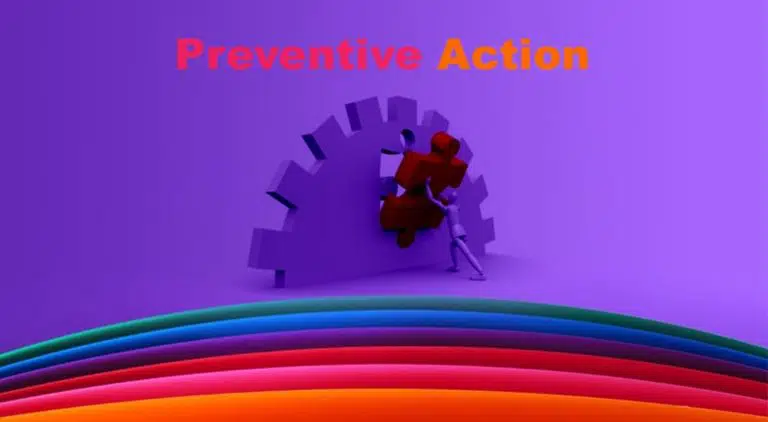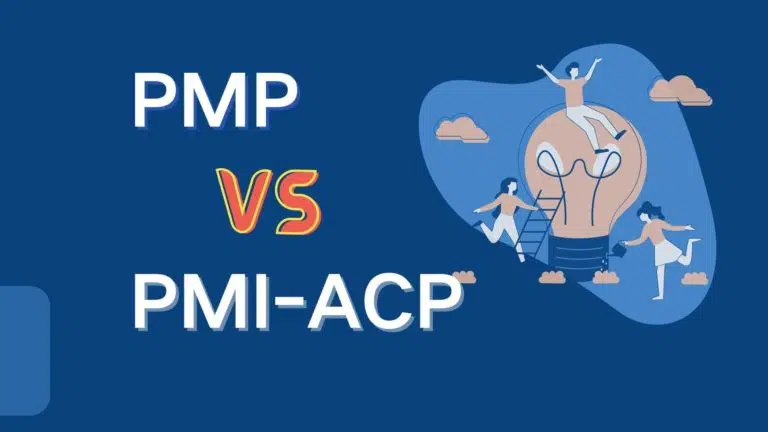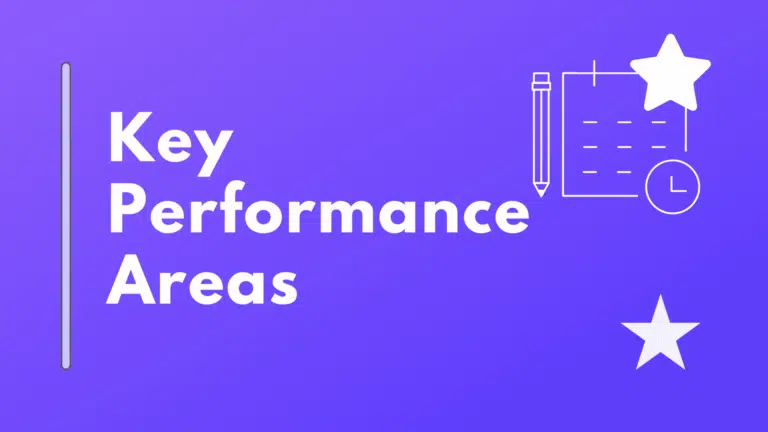Project management artifacts allow stakeholders to grasp its purpose, objectives, and characteristics.
In this article, we’ll learn about project artifacts and their importance in project management.
What are Project Artifacts?
Definition: Any written document that an organization produces to outline and support a project’s workflow is considered a project artifact. Documents, results, deliverables, objectives, and formats are examples of project management artifacts.
They support stakeholders’ requirements, establish expectations, and align projects with the organization’s goals. Project artifacts include things like project charter, customer studies, and business cases, among other things.
Since the majority of artifacts are live project documents, most of them can be updated. They supply information that pertains to the project. Artifacts define deliverables, documentation, templates, etc.
Documentation for the project is generated through the use of artifacts. The team produces these artifacts at various stages throughout the project’s lifecycle. The project artifacts outline the activities necessary to produce deliverables.
For example
Task: Assembling the project team
Deliverable: A list of the team members
Artifact: Register team roles, section criteria, and a list of necessary abilities
Definition of Artifacts in the PMBOK Guide (Sixth & Seventh Edition)
According to the PMBOK Guide 7th Edition, an artifact will be a template, document, output, or project deliverable.
(Project Management Body Guide of Knowledge, section 4.1. The Project Management Institute, 2021).
In the PMBOK Guide 6th Edition, in section 1.11 of Tailoring the Project Artifacts of the standards of 2017, we find:
The term artifact includes project management processes, inputs, tools, techniques, outputs, EEFs, and OPAs.
(Project Management Body Guide of Knowledge, Sixth Edition, section 11.1. The Project Management Institute, 2017)
According to the PBMOK Guide, project artifacts include processes, deliverables, documents, tools, and techniques for project management.
Examples of Project Artifacts
According to the PMBOK Guide 7th Edition, the following are examples of project artifacts.
- Project Charter
- Risk Register
- Stakeholder Engagement Plan
- Prioritization Matrix
- User Story
- Value Stream Map
Role of Project Artifacts in Project Management
- Project artifacts are essential in project management as they document the project objectives and deliverables.
- Project artifacts ensure that a project is completed and finished efficiently.
- Project managers use them to assess a project’s development and update the plans if required.
- Project artifacts help in project planning.
- They facilitate communication amongst the stakeholders.
- Project artifacts help a project manager deal with risks.
- They help with resource planning and allocation.
- Project artifacts make the project traceable and trackable.
- They help project managers incorporate necessary changes easily.
Types of Artifacts in Project Management
Some common artifacts in project management are as follows:
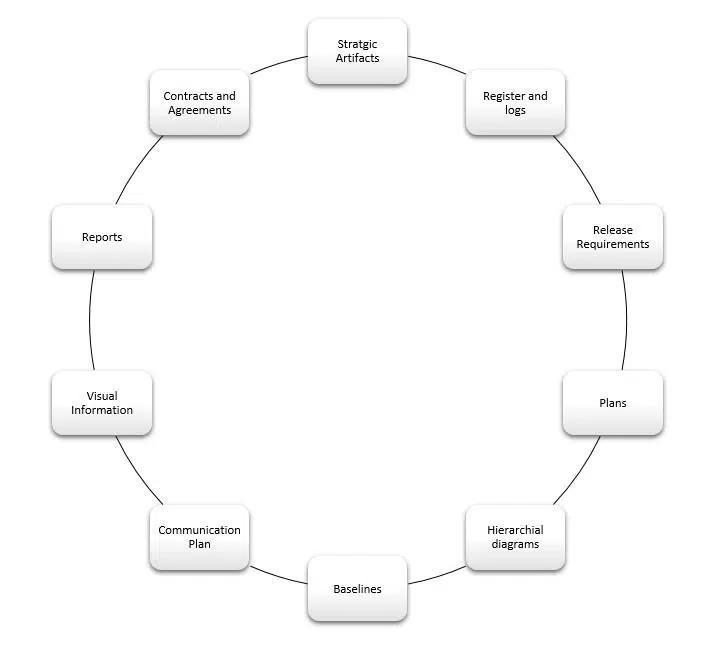
#1. Strategy Artifacts
The business case, the feasibility study, the cost-benefit analysis, and other similar documents are all examples of artifacts related to strategy. Before work on the project even begins, the strategy artifacts are crafted. Because they are concentrated on the project’s overall strategy, these artifacts do not change as the work progresses.
The following are examples of strategy artifacts: project proposals, project charters, vision statements, business maps, and road maps.
These documents outline important project components such as the description, scope, available resources, timetable, and roles.
#2. Registries and Logs
Logs and registers are included in this category. They include things like the stakeholder register, the backlog, the issue log, and the risk register, among other things. A project manager can use these artifacts to evaluate how far along a project is and decide which tasks need to be completed on a given workday with their assistance.
During the project’s life cycle, these logs will undergo numerous modifications.
#3. Release Requirements
Testing prototypes, development units, and finished products are made easier for the project team thanks to the release requirements. Release requirements include vision statements, assessment standards, developer-buyer agreements, etc. Evaluation criteria help determine whether or not a project has successfully accomplished its goals.
#4. Plans
Plans are essential artifacts of a project that managers produce to carry out the work, monitor the progress, and successfully complete the project. This document may include one or more artifacts that combine textual and visual components.
The project plan includes a risk management plan, communication management plan, resource management plan, scope management plan, procurement management plan, etc.
The project manager and the stakeholders will easily navigate the project with plans. Written documents and diagrams both qualify as plans.
#5. Hierarchical Diagrams
The link between various project components, such as the risk breakdown structure, organizational breakdown structure, product, and work breakdown structure, is described using hierarchy charts.
#6. Baselines
The project cannot move forward without baselines, which are versions of the plans that have already been approved. The milestone plans, cost baseline, schedule baseline, and scope baseline, as well as any other performance assessment baselines, are all included in the project baselines.
#7. Communication Plans
A communication strategy is developed by a project team while they are working on a project to determine the most effective ways to deliver information. As an illustration, they can devise strategies for efficient communication regarding conferences, issues, document reviews, access to deliverables, and the current standing of the project.
#8. Visual Information
This category includes any charts and documents that contain graphics. This includes various visualizations such as flow charts, dashboards, requirements traceability matrices, and velocity charts. When used appropriately, visual data sources can make the process of communicating information much simpler.
Following the data analysis, a project manager may produce visual information and use methods to update data automatically.
#9. Reports
Project management involves dealing with a lot of reports. Reports include status, risk, quality reports, and formal records for stakeholders.
#10. Contracts and Agreements
A project can have multiple procurement contracts and agreements. For instance, purchase orders for the acquisition of consumables, procurement contracts for the acquisition of services or the subcontracting of work, etc. You might be required to sign a contract when hiring staff or experts.
Examples of contracts and agreements include a cost-reimbursable and fixed-price contract, a contract with a time-and-materials agreement, a contract with a legally binding clause, and many others.
Other Artifacts
The artifacts that fall under this category are user stories, team charters, bid papers, etc.
Project Management Artifacts by Phase
The following table shows the project artifact by phases of project management:
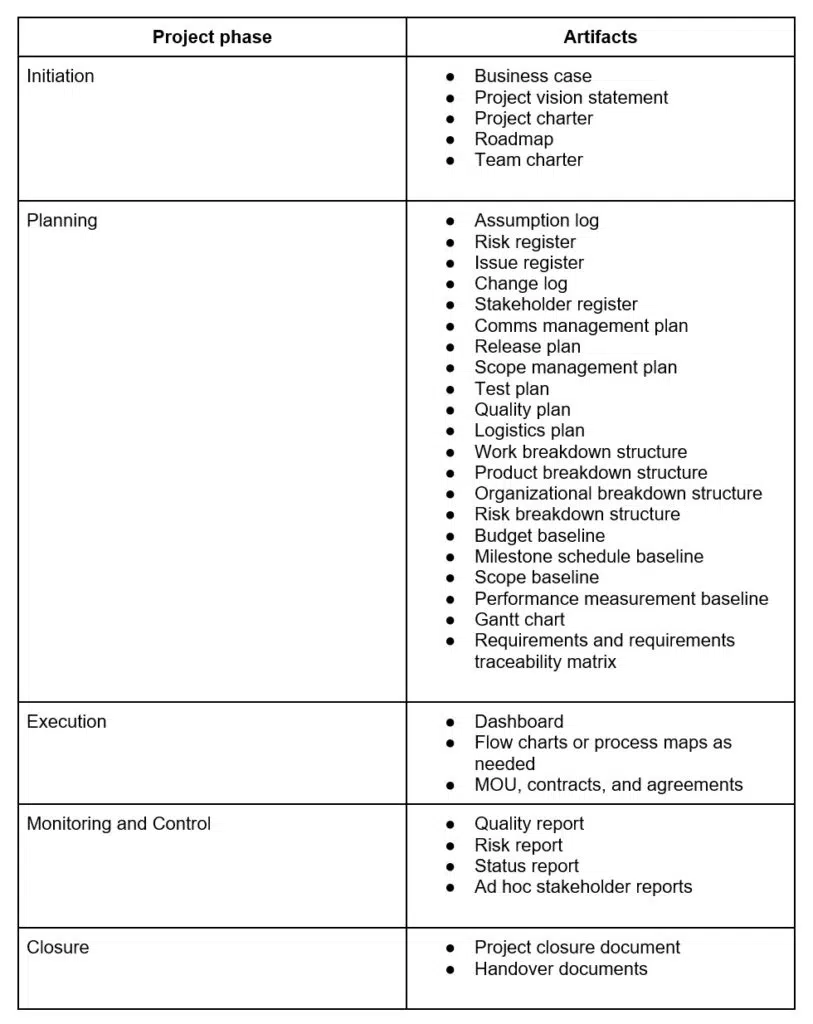
Pre-Initiation Phase
In this stage, the project artifacts comprise a business case, a task description, an estimation of resources and timelines, an impact of not executing work, several alternatives, and a business case.
Initiation Phase
At this point, you will have a project charter that details all of the necessary sections for the project, such as roles, a specific scope, and a project description. You will also have a clear understanding of the project’s scope. The stakeholder register is another important document, which includes a list of those who have a stake in the project.
Planning
The planning stage includes various project management plans and other project management documents.
Throughout the project’s life cycle, these documents serve as a roadmap for the project team to follow as they carry out the work, monitor and control it, and so on.
Execution Phase
Actual work is carried out in this phase. You spend most of your funds and time in this phase.
Monitoring & Controlling Phase
Tracking is crucial to monitoring a project; it helps take corrective and preventive actions if required. You can use an Excel workbook, SharePoint list, or other comparable spreadsheet applications to keep track of project progress.
Closing Phase
In this phase, the deliverable is delivered, the project is closed, lessons learned, organizational process assets are updated, and the project team is released.
Why Are Project Artifacts Important?
The advantages provided by project artifacts are not limited to the development teams. They describe the program’s objectives, performance criteria, and product features.
A few important aspects of project artifacts are as follows:
They Act as a Timeline for a Project
Project artifacts serve as the foundation of project management by giving team leaders a flowchart for a project from beginning to end. Without artifacts, knowing the tools for managing a project will be challenging.
Time Efficiency
It is important to have project artifacts to have effective project management because these artifacts provide the project with both structure and direction. They make it easier for project managers to move quickly through processes and procedures, reducing the amount of work they have to do. Project artifacts let project managers maneuver around obstacles and avoid issues.
They Aid in Resolving Issues
The project management environment is dynamic, and it always has some issues and risks. Project artifacts help handle all these issues.
Providing Useful Information
Project artifacts include many project management documents. Therefore, they can be regarded as a knowledge base that can answer all the questions a new team member might have about a project.
Conclusion
You can improve the efficiency of your project management by using the artifacts of the project. These live documents can be utilized for various purposes, including the maintenance of a record, the execution of a plan, and the communication of information to the relevant stakeholders.
Depending on the circumstances, a project manager needs to choose the artifacts that are appropriate.

I am Mohammad Fahad Usmani, B.E. PMP, PMI-RMP. I have been blogging on project management topics since 2011. To date, thousands of professionals have passed the PMP exam using my resources.



